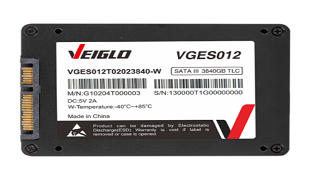The Ultimate Guide on Industrial SSD and Its Flash Memory Classification
2022-02-21 | admin

Solid State Drives (SSD) are storage devices used in operating systems in every major industry. Industries such as medical facilities, data centers, military, in-vehicle computing, aerospace, and aviation need to access and process data faster from their digital database, which industrial SSD drives help with.
Industrial SSD drives are specifically modeled to read/write data faster, occupy less space, and provide better data protection and temperature fluctuation. Our detailed guide will help you explore the various types of SSD drives and assist you in deciding which industrial SSD is suitable for your needs.
In the 1970s and 1980s, SSDs were used in the semiconductor memory of early supercomputers, including IBM, Amdahl, and Cray. But their use was limited due to their high prices. Then, in the 1970s, General Instruments produced EAROM, which was much similar to the NAND Flash memory that we use today.
In 1978 Texas Memory System developed the first 16-kilobyte RAM SSD, which oil companies initially used. After this, the solid-state drive began its developmental phase. Finally, in 2007 a PCIe SSD was designed to write and read 100,000 operations per second, having a storing capacity of up to 320 GB.
There are different types of flash memories used in the industrial SSD available in the market. Three main categories of them include the following:
§ SLC: Single-Level Cell (SLC) is a basic type of industrial SSD. It accepts one bit per memory cell and can rate 100,000 writes per cycle. This makes SLC SSD reliable for processing data faster while also eliminating chances of errors. Due to their supreme performance level and durable nature, they are preferred by commercial and industrial organizations.
§ MLC: Multi-Level Cells (MLC) can store two bits per cell and rate 10,000 writes per cycle. This affects their performance while writing operations and makes them less suitable for longer use. It is ideally used in consumer devices such as smartphones and cameras.
§ TLC: Triple-Layer cells write three bits to each cell. They are typically used for web hosting, streaming, and workloads that only require reading.
Industrial SSD is focused on wide temperature range, stability, MTBF (Mean Time Between Failures), power consumption, and reliability. So, which NAND flash performs the best in these vital aspects? Below is the comparison of the three types of SSDs: TLC vs. MLC vs. SLC.
Considering the harsh working environment in industries like aerospace, cold chains, and machinery, you are recommended to choose an SSD with a wide working temperature range. In this case, SLC has the widest working temperature, MLC ranks second, and TLC the third.
MTBF stands for the Mean Time Between Failures, and it is related to the stability of an SSD. The longer the meantime, the stabler the SSD. One factor that decides the MTBF is the type of flash memories: an unstable NAND flash may cause data storage failure that shortens the meantime. Because the MLC and TLC have more cell bits, they are prone to produce errors when reading the data. Therefore, the SLC has the highest MTBF, MLC is lower, and TLC is the lowest.
It is vital for the industry to control power consumption since it often takes up a high cost. In this case, the three types of NAND flash nearly consume the same and small amount of electric resource.
SLC with the lowest data density per NAND cell contributes to the most reliable SSD. What cannot be denied is that MLC and TLC are less reliable than SLC, but with the powerful ECC function (Embedded Error Correction), they can still ensure accuracy when reading the data.

Industries are always evolving and making things available to a wider audience. This makes it necessary to secure rapid data collection and ensure a timely transfer of information. VEIGLO fused their in-depth research on solid-state storage devices with innovative technology to create the 2.5” SATA SSD. The precision of this SSD will bring you many benefits, including:
This industrial-level SSD Drive offers a range of capacities to its users. The 2.5” SATA SSD comes in a range of series with storing capacity ranging from 2TB to 8TB. It gives you more storage with excellent performance.
The SSD Drive can resist wide fluctuations in temperature. If your system is running most of the time, the temperature of the drive still won’t be affected. These drives can tolerate a high-temperature range of -40° - 85°C, making them suitable for hotter and colder working environments.
Since the drives can cope with wide temperatures, they will continue to serve you for a longer time. VEIGLO will become your one-time investment and will last for years to come.
This SATA SSD Drive comes with a built-in Embedded Error Correction Code (EEC), which further eliminates the chances of making any errors while recovering data. The EEC technique can rectify errors in the NAND Flash, providing high stability and ensuring users get accurate information.
SATA SSD is a perfect solution for your system because it comes with a dynamic power management feature. To put it simply, this industrial SSD consumes less battery, allowing you to perform more work without heating your system.
VEIGLO, being a professional data storage company, offers you the incredible industrial 2.5” SATA SSD to fully meet the increasing storing demand of growing industries. With its years of manufacturing experience on solid-state storage products, we keep doing in-depth research to develop perfect data storage solutions for our clients and safeguard their confidential information.
Previous: What Challenges Does Medical Data Storage Meet in the COVID-19 Pandemic?
Next: 6 New Challenges to SSD on Chip for Realization of Autopilot Driving